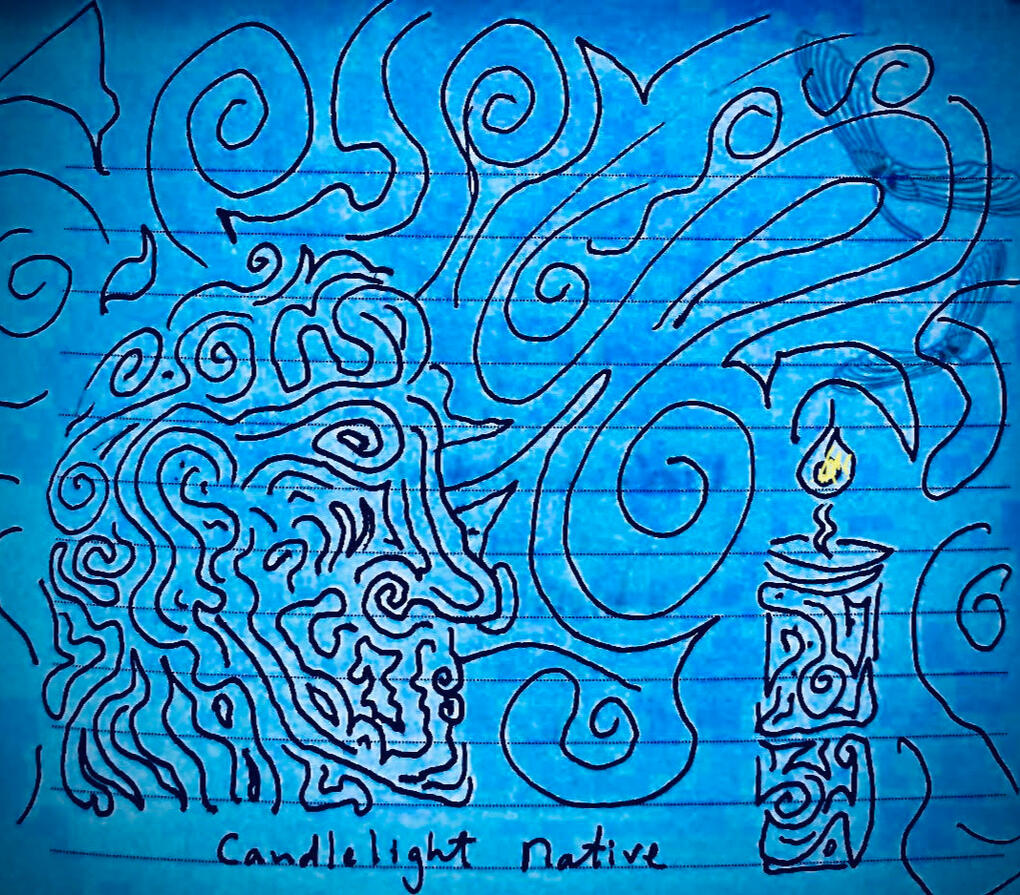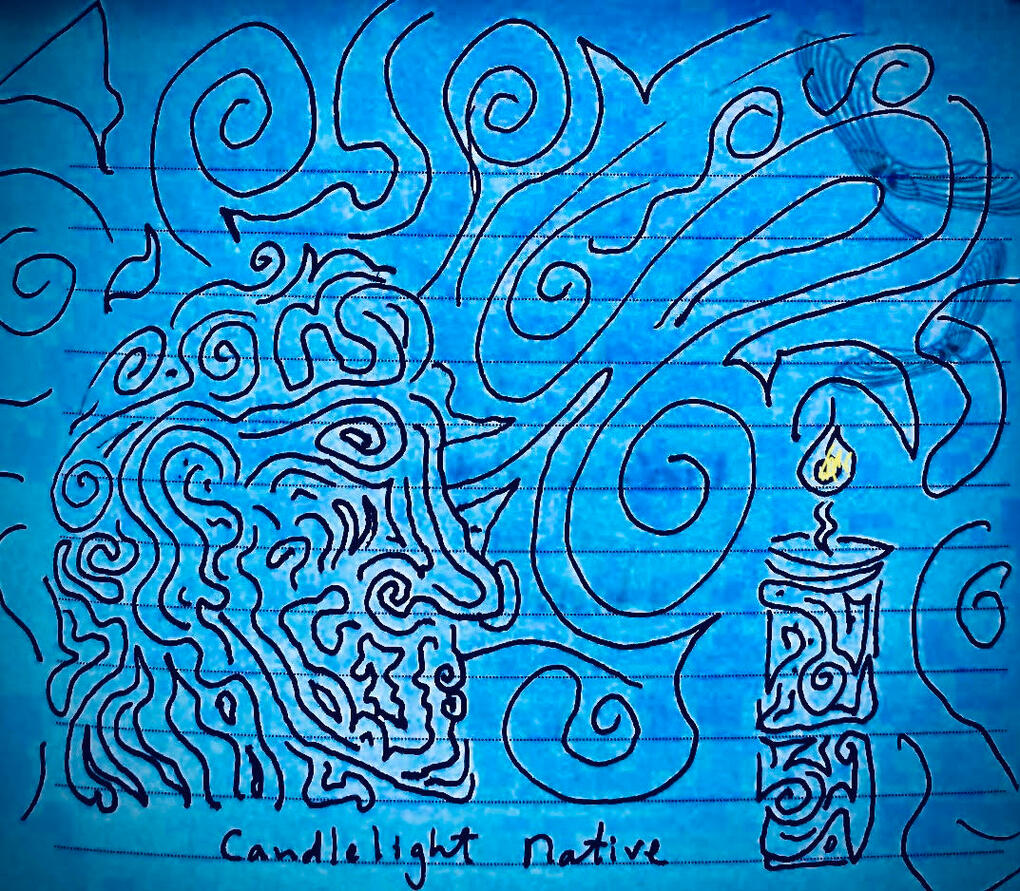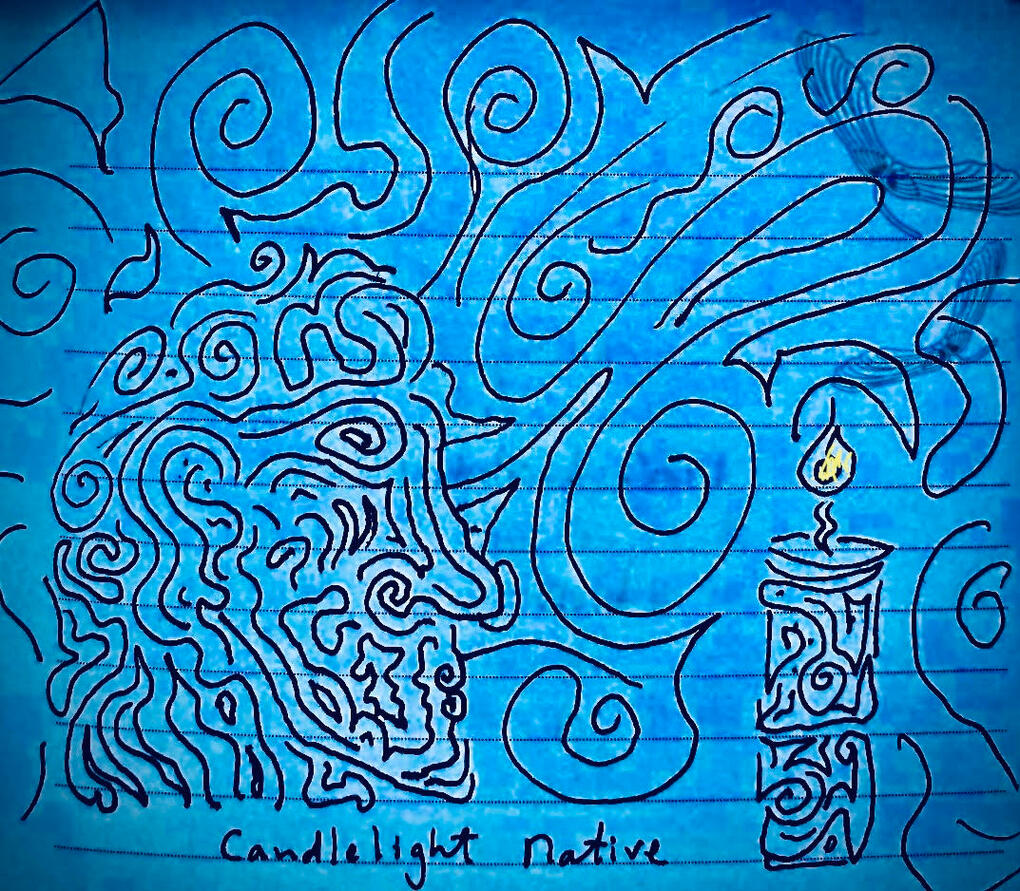Candlelight Native
CSUCI Capstone 2022
Brite, Mike Biscoe and Jerry Cruz


Who what where when why how
WHO? Brite (Comm. partner); Mike (lead); Jerry (support)
WHAT? Connect sessions that start with a creative launch point (music, art, creative writing)
WHEN? April 19, 22, 26, and 29th
WHERE? Wellness Center @ Oxnard Union High School
WHY? How do we cope when isolated or depressed? What strategies do we employ to help us cope more efficiently? Our overt goal is to leave everyone with new ideas about how to cope. Our less overt goal is that the format of the chats, in-person groups, constitutes part of the answer-connection is crucial.
HOW? Day 1 launch point: music. Day 2 launch point: art + writing. Day 3: A visit with Doc
Annotated Bibliography
Questions to answer
1. What is coping?
2. What is creativity?
3. Do coping mechanisms matter?
4. Does community matter?
5. How can coping mechanisms be used to support ourselves?
6. Does the role of coping mechanisms change during increased stress?
7. Should problem solving be an incessant pursuit?
8. How is staying connected to what you love important?Moore, R. C., Strauss, E., Campbell, L. M., (2020) Handbook of Mental Health and Aging. Third Edition, Academic Press, pp. 37-58The source for mental health definitions and descriptions. Used extensively by mental health professionals. Basically a dictionary of every mental health term ever. This is a great source to back up any statements made in relation to mental health in the paper.Montero-Marin J., Prado-Abril J., Piva Demarzo M. M., Gascon S., García-Campayo J. (2014) Coping with Stress and Types of Burnout: Explanatory Power of Different Coping Strategies. PLoS ONE 9(2): e89090. https://doi.org/10.1371/journal.pone.0089090Focus of this article is largely on responses to burnout. In particular, employment burnout and its impact in causing mental stress. Additionally, there is an emphasis on naming different coping mechanisms used depending on type of burnout (yes, there is more than one type). There is a good definition of coping too.Reevy, G., Frydenberg, E., (2011) Personality, Stress, and Coping Implications for Education. Information Age PublishingAnother source for a definition and specific information on coping mechanisms. Especially relevant as there is a focus in chapter one and two on adolescent coping which might be useful as far as the outreach with Frontier High School. Emphasis on coping and bullying.Garber, M. C., (2017), Exercise as a Stress Coping Mechanism in a Pharmacy Student Population, American Journal of Pharmaceutical Education, 2017-04, Vol. 81, No. 3, pp. 1i+, https://doi.org/10.5688/ajpe81350This would be a useful source for explaining the different types of coping (positive/negative). Focus is on students, though they are pharmacy students and not high school students. Could also be a reference for my own situation and how I coped during the pandemic by walking frequently.Choi, M., Tessler, H., Kao, G., (2020), Arts and Crafts as an educational strategy and coping mechanism for Republic of Korea and United States parents during the COVID-19 pandemic, International Review of Education, Vol. 66, pp. 715-735, https://doi-org.ezproxy.csuci.edu/10.1007/s11159-020-09865-8Arts and crafts focus of this article is relatable to the slide show drawings. Tactile aspect of arts and crafts is relatable to playing guitar live during slide show. Also, I like the tactile emphasis here because it can be a tool to live in the now-as opposed to brooding on a problem incessantly. Could aid in coping. A large amount of focus is placed on the family and parental strategy during the pandemic—in other words, how do parents get what needs doing done and keep their kids entertained at the same time?Franken, R. E., (1994), Human Motivation, 3rd Edition, Brooks/Cole Publishing CompanyMainly relevant for its definition of creativity. This book considers major themes and ideas about human motivation. Franken enlists biology, cognition and learning mix with our own uniqueness to form our behavior.Ettman, C. K., Abdalla, S. M., Cohen, G. H., Sampson, L., Vivier, P. M., Galea, S., (2020), Prevalence of Depression Symptoms in US Adults Before and During the COVID-19 Pandemic, Journal of the American Medical Association, JAMA Network Open. 2020;3(9):e2019686. https://doi.org/10.1001/jamanetworkopen.2020.19686Good source for stats on depression before and during the pandemic. Expected vast differences. Useful as a setup to discussing my own depression. But more for its relevance to the importance of coping mechanisms.Soloman, A., (2015), The Noonday Demon: an atlas of depression. New York: ScribnerGreat source on depression. Could be used for bridge between the statistical and personal experience. “An Atlas of Depression” is part of the title. Lucidly written. Uses both biological and personal description of the disease. A tome but well indexed and oddly readable. Considers depression from every conceivable angle.Xiang, M., Yamamoto, S., Mizoue, T., (2020), Depressive Symptoms in Students During School Closure Due to COVID-19 in Shanghai, Psychiatry and Clinical Neurosciences, Vol. 74, Issue 12, December 2020, pp. 664-666, https://doi.org/10.1111/pcn.13161Study from China focusing on increased depression symptoms in students and two months of classrooms being closed. There findings curiously suggest that there were no increases of depression. I might be able to use this as a counter to the other articles on depression as a means of stating that everyone’s reaction to stress is different. Hence, the necessity to focus individually as part of the project.Nietzsche, F., Kaufmann, W., (1974), The Gay Science, New York: Random HouseThis could be used as segue material through author’s commentary on the death of God, among other immense philosophical ideas. Includes poetry, song, observations.Berkman, L., (1984), Assessing the Physical Health Effects of Social Networks and Social Support, Annual Review of Public Health, 5:413-32, https://www.annualreviews.org/doi/pdf/10.1146/annurev.pu.05.050184.002213Importance of community. Connections between lack of community and cardiovascular disease. Increased stress levels among those who experience less community. Could use for definition or elaboration of why community is important. Good section on function of social ties with a list of terms and elaboration of terms.Fiori K. L., Jager J., (2012) The Impact of Social Networks on Mental and Physical Health in the Transition to Older Adulthood: A longitudinal, pattern-centered approach, International Journal of Behavioral Development, 36(2), pp.117-129. doi:10.1177/0165025411424089Another journal article with a community focus. Emphasis is on older adults but more information on community/social ties and health might be useful. There is also a demographic element (age, gender, marital status, education, and income).Ariga, A., Lleras, A., (2011) Brief and rare mental “breaks” keep you focused: Deactivation and reactivation of task goals preempt vigilance decrements, Cognition, Vol. 118, Issue 3, March 2011, pp. 439-443, https://doi.org/10.1016/j.cognition.2010.12.007Focus of this article is in exploring how we maintain prolonged focus and how we can enhance this through use of strategic breaks.Vigilance decrement, goal habituation, and task switching are all considered. This article can be used to back up the idea that breaks can be useful (as opposed to trying to problem solve until blue in the face)Moutinho, S., (2021), Edison was right: Waking up right after drifting off to sleep can boost creativity, Science, News/Brain & Behavior, 8 Dec. 2021, https://doi.org/10.1126/science.acx9794Brief article that explains how Edison’s habit of napping with a ball in his hand—and dropping it as he catnapped—boosted his creativity. Mentions studies that have proven this. This can be used as an example of how even short-term rerouting can benefit being stuff while trying to cope.

Contact
Lorem ipsum dolor sit amet, consectetur adipiscing elit. Praesent vestibulum risus sit amet lectus condimentum, ac fermentum nibh ullamcorper magna.
Thank you
Lorem ipsum dolor sit amet, consectetur adipiscing elit. Praesent vestibulum risus sit amet lectus condimentum, ac fermentum nibh ullamcorper magna.